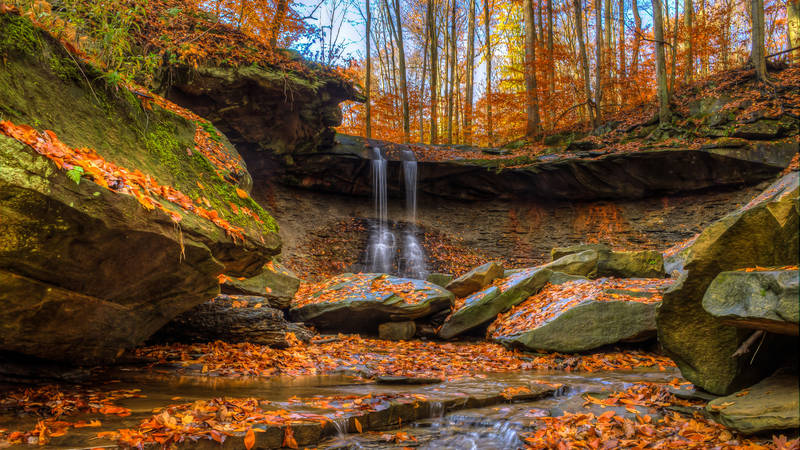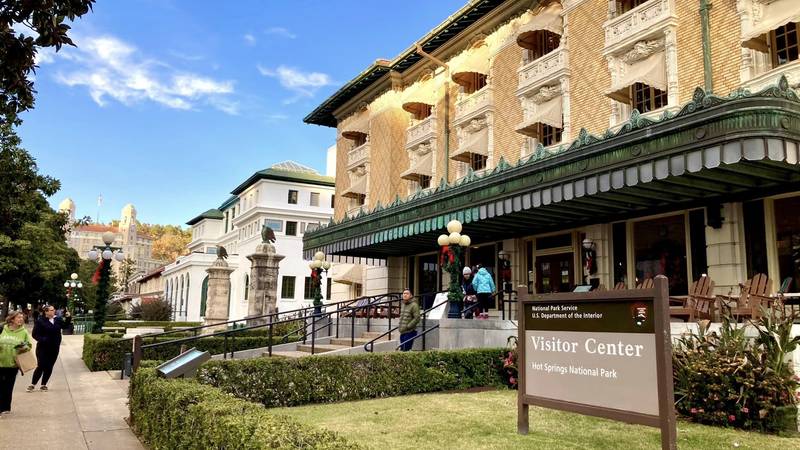The Great American Outdoors Act is providing crucial funding – up to $6.65 billion over five years – to fix our national parks’ crumbling roads, decaying buildings, outdated water systems and many more repair needs.
Nearly four years ago, through the persistence and dedication of NPCA and park advocates across the country, we witnessed the historic, bipartisan passage of the Great American Outdoors Act (GAOA). This dedicated funding is addressing hundreds of overdue maintenance projects in national parks, such as crumbling roads, worn-out trails, failing water and sewer systems, and other maintenance issues. It also is greatly improving visitor experiences for the millions of people who travel to these treasured places every year.

9 Park Success Stories Advocates Made Possible
On the two-year anniversary of the Great American Outdoors Act, parks around the country are seeing big, tangible improvements as a result of this historic bipartisan victory.
See more ›Since its passage, GAOA has addressed billions of dollars in repair needs in nearly every state, including fixing damaged trails at Mammoth Cave National Park, replacing a failing water system at Organ Pipe Cactus National Monument, rehabilitating staff housing at Glacier Bay and Great Sand Dunes national parks, and enhancing campgrounds at Yosemite, Rocky Mountain and Mount Rainier national parks.
While each park’s repair needs differ in size and scope, they exist because of a common problem: insufficient congressional funding. They’ve been put on the backburner for decades, which is far too long.
Despite the progress GAOA has made, the challenge persists, as the backlog of repair needs at national parks has reached $23 billion. The cost of routine maintenance needs simply outpaces annual funding from Congress.
Through 2025, GAOA will continue to address critical repair projects and improve visitor experiences in parks, but the current funding won’t be able to repair every broken bathroom, deteriorating trail or outdated visitor center. Congress made huge strides with the passage of GAOA, but it’s clear that our parks need more help to protect the natural and cultural resources that tell our nation’s history and ensure parks can continue to welcome millions of visitors each year.
We urge Congress to extend GAOA’s national park maintenance fund by providing at least five more years of needed investment to fix our parks.
Restoring America’s National Parks and Public Lands: Great American Outdoors Act Improves Visitor Expreience and Preserves Our Nation’s History
Lewis River Bridge Improvement Project: June 21, 2023 ©NPS, Jacob W. FrankRehabilitation of one mile of trail at Mammoth Cave National Park in Kentucky. Improving access and safety via hardening the trail surface, installing new handrails and curbs and renovating several sets of stairs.
Mammoth Cave National Park ©NPSRepaved trail through Cherry Spring Nature Area in Caribou-Targhee National Forest in Idaho. The rehabilitation of the trail included widening the path to improve accessibility for those with disabilities.
USDA Forest Service, Crystal YoungRepair of the Big Four Ice Caves Bridge at Mt. Baker-Snoqualmie National Forest in Washington State. More than 60,000 people use the footbridge to access the 1.1 mile-Ice Caves Trail; however, it was closed in 2019 due to safety reasons. The bridge was reopened in the summer of 2023 and expanded to allow wheelchair accessibility.
USDA Forest Service, Lucas SilvisTrail maintenance along the Landers Fork Trail connecting the Bob Marshall Wilderness Complex and adjacent lands to the Continental Divide National Scenic Trail in Montana. Repairs removed vegetation overgrowth and fixed washed out trails by flooding that impeded access.
USDA Forest Service, Madeline RubidaHabitat restoration at Kootenai National Wildlife Refuge in Idaho. Funding helped restore water structures and remove invasive species from the refuge to support hundreds of species of waterfowl that use the refuge to rest, feed and raise their young.
Kootenai NWR - Scenic, Carlene Hardt | FWS.govRestoration and modernization of the Tuolumne Meadows campground in Yosemite National Park. This major project will upgrade campground facilities and utility systems. It will also convert a campground road to a hiking trail to better protect the adjacent Tuolumne Wild and Scenic River.
Yosemite National Park ©NPSGeorge Hall House roof repairs at Minute Man National Historical Park in Massachusetts. This historical park is the location of the opening battle of the American Revolution in 1775 and a key location for celebrating the 250th Anniversary of our nation.
Minute Man National Historical Park ©NPSRehabilitation of parking areas, sidewalks and the historic main parade ground barracks building at Fort Vancouver National Historic Site in Washington State. This work will continue to adapt the historic military site for public use and improve accessibility.
Fort Vancouver National Historic Site ©NPS, Bill PersonsRehabilitated bunkhouse at Kenai National Wildlife Refuge in Alaska. Kenai provides worldclass fishing, camping and hiking opportunities for people around the world.
Kenai National Wildlife Refuge ©USFWSCompleted structural repairs and repainting of the 114-yearold Punta Gorda Light Station in California. The station was a beacon for ship navigation from about 1910 until 1951 and is listed on the National Register of Historic Places.
Punta Gorda Light Station ©BLM, Mark StranskyRehabilitation of the Texas White House Complex at Lyndon B. Johnson National Historical Park. The house closed in 2018 due to health and safety concerns and is currently being restored by repairing structural components, removing mold and improving building accessibility.
Lyndon B. Johnson National Historical Park ©NPSNew accessible toilets were installed at six different locations throughout the Superior National Forest in Minnesota. These facilities provide a necessary convenience for all visitors to the national forest.
Jackpot ATV Trail ©USDA Forest ServiceRebuilt headquarters and visitor center at Crab Orchard National Wildlife Refuge in Illinois. This will enhance the visitor experience in the 44,000 acres refuge with a wide diversity of wildlife and plants
Crab Orchard National Wildlife Refuge ©USFWSRestoration of the historic Wade and Curtis Cabin at Gates of Lodore in Dinosaur National Monument in Colorado. Renovations included repairs to the foundation, roof, walls, windows, floor, electrical outlets and more for visitors to enjoy and learn about the history of the area.
Dinosaur National Monument. ©NPSNew school and support buildings for the Wounded Knee District School, affiliated with the Lakota Sioux Nation, in South Dakota. This investment provides LEED certified buildings, improves water distribution and sewer collection, reconstructs roads and sidewalks for students from kindergarten to 8th grade.
Wounded Knee District School ©DOIReplacement of the Sourdough Campground Bridge over the Gulkana Wild and Scenic River in Alaska. The replacement restored public access for thousands of visitors per year to the campground’s boat launch, a popular spot for water-based activities.
Sourdough Campground Bridge ©BLMRehabilitation of the 50-year-old Saratoga Battlefield Tour Road at Saratoga National Historical Park in New York. The project improves the visitor experience by restoring educational waysides, parking, walkways and viewing areas along the 10-mile route.
Saratoga National Historical Park ©NPSReplacement of the Laurel Fork Bridge at Blue Ridge Parkway in North Carolina. Funding will replace the 80-year-old, 550-footlong bridge that reached the end of its service life and closed during periods of high wind.
Blue Ridge Parkway ©NPSImprovements to natural surface roads in the Bureau of Land Management Las Cruces District in New Mexico. These roads provide access for multiple federal agencies and private companies to access radio and cell towers. Also, they provide recreational access to view fossils, hike and horseback ride.
Las Cruces District ©BLMView or Download the Photobook Restoring America’s National Parks and Public Lands
Examples of Great American Outdoors Act projects:
- Acadia National Park, Maine

The McFarland maintenance operations complex at Acadia National Park.
© Lauren Cosgrove/NPCAA $19.9 million GAOA investment will fund a new maintenance complex with parking, roads, storage, utilities and septic. The funding will also allow workers to demolish the unsafe, undersized existing structures. The upgrade will improve workplace efficiency, decrease annual operating costs, protect equipment, address critical health and safety concerns, and improve universal access.
- Saratoga National Historical Park, New York

A cabin and canon mark the battlefield at Saratoga National Historical Park in New York.
© Donnie Shackleford/DreamstimeA $5 million GAOA investment will help the park update and rehabilitate worn signage and provide universal accessibility on all routes, parking areas, trailheads, walkways and seating areas along the battlefield tour. Sixty durable new exhibits will offer audio and tactile components and improved interpretation to better connect all visitors with the importance of the site.
- Hot Springs National Park, Arkansas

Bathhouse Row at Hot Springs National Park.
Christina MayA multi-million-dollar investment from the GAOA will restore two historic bathhouse buildings and make them more accessible, safe and energy efficient for visitors: the Maurice Bathhouse and the former Libbey Memorial Physical Medicine Center. Decades of decay make them unusable without major rehabilitation. When the work is complete, the park can lease these structures to private businesses, bringing more income to the Park System.
- Rocky Mountain National Park, Colorado

Rocky Mountain National Park
Photo © Scott Kirkwood/NPCA.A $31.9 million investment from GAOA will improve the park’s largest front-country campground’s infrastructure for water, sewer and electricity, which have not been updated since it was first built in the 1960s. The project will also increase accessibility, rehabilitate a ranger station, add food storage lockers and concrete pads to campsites, and improve roads and parking, greatly improving the visitor experience.
- New River Gorge National Park and Preserve, West Virginia

Sandstone Falls at New River Gorge National Park and Preserve
© Janet Everhard/DreamstimeA $1 million GAOA investment will help the park remove about 20 non-historic, deteriorating, unsound structures and restore native plants, returning these sites to their natural condition and making these additional areas available to visitors for recreation. This project will remove hazards from the park and reduce operational costs, allowing staff to focus financial resources on higher priority projects that better serve the public.
- Glacier National Park, Montana

Logan Pass at Glacier National Park, Montana.
Logan Pass at Glacier National Park, Montana. ©KAN1234 | DREAMSTIME.COMThrough a $21 million GAOA investment, the park will rehabilitate the Going-to-the-Sun Road and replace the bridge over McDonald Creek. The life of the roadway will extend by another 20-30 years, and the new bridge will have viewing sidewalks on both sides and will be rated for highway loads, capable of carrying all types of vehicles. Both projects will create a safer visitor experience and increase access to scenic views.
Get Action Alerts
Want national parks in your inbox? Sign up for NPCA email updates to receive news, features, and opportunities to make a difference! You can unsubscribe at any time.



















